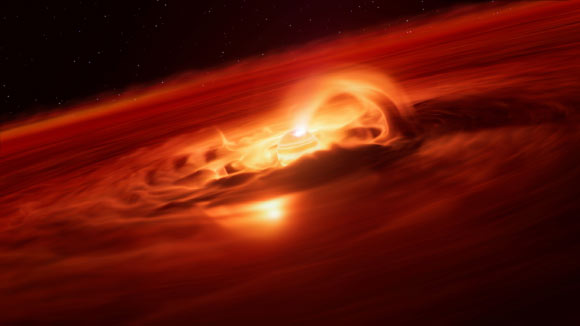Cha J11070768-7626326 (Cha 1107-7626 for short), a young, isolated exoplanet between 5 and 10 times the mass of Jupiter, has experienced a record-breaking ‘growth spurt,’ hoovering up some 6 billion tons of gas and dust each second over a couple of months, according to new observations made with ESO’s Very Large Telescope.

An artist’s impression of the free-floating exoplanet Cha 1107-7626. Image credit: ESO / L. Calçada / M. Kornmesser.
Cha 1107-7626 is located approximately 620 light-years away in the constellation of Chamaeleon.
This free-floating exoplanet is still forming and is fed by a circumplanetary disk of gas and dust.
This material constantly falls onto the planet, a process known as accretion.
By August 2025, Cha 1107-7626 was accreting about 8 times faster than just a few months before, at a rate of 6 billion ton per second.
“People may think of planets as quiet and stable worlds, but with this discovery we see that planetary-mass objects freely floating in space can be exciting places,” said Dr. Víctor Almendros-Abad, an astronomer with the Astronomical Observatory of Palermo at the National Institute for Astrophysics (INAF).
“We’ve caught this newborn rogue planet in the act of gobbling up stuff at a furious pace,” said Johns Hopkins University’s Professor Ray Jayawardhana.
“Monitoring its behavior over the past few months, with two of the most powerful telescopes on the ground and in space, we have captured a rare glimpse into the baby phase of isolated objects not much heftier than Jupiter.”
“Their infancy appears to be much more tumultuous than we had realized.”
“This is the strongest accretion episode ever recorded for a planetary-mass object,” Dr. Almendros-Abad added.
The discovery was made with the X-SHOOTER spectrograph on ESO’s Very Large Telescope (VLT), located in Chile’s Atacama Desert.
The astronomers also used data from the NASA/ESA/CSA James Webb Space Telescope and archival data from the SINFONI spectrograph on VLT.
“The origin of rogue planets remains an open question: are they the lowest-mass objects formed like stars, or giant planets ejected from their birth systems?” said Dr. Aleks Scholz, an astronomer at the University of St Andrews.
The findings indicate that at least some rogue planets may share a similar formation path to stars since similar bursts of accretion have been spotted in young stars before.
“This discovery blurs the line between stars and planets and gives us a sneak peek into the earliest formation periods of rogue planets,” said Dr. Belinda Damian, an astronomer at the University of St Andrews.
By comparing the light emitted before and during the burst, the astronomers gathered clues about the nature of the accretion process.
Remarkably, magnetic activity appears to have played a role in driving the dramatic infall of mass, something that has only been observed in stars before.
This suggests that even low-mass objects can possess strong magnetic fields capable of powering such accretion events.
The team also found that the chemistry of the disk around the planet changed during the accretion episode, with water vapor being detected during it but not before.
This phenomenon had been spotted in stars but never in a planet of any kind.
“We’re struck by quite how much the infancy of free-floating planetary-mass objects resembles that of stars like the Sun,” Professor Jayawardhana said.
“Our new findings underscore that similarity, and imply that some objects comparable to giant planets form the way stars do, from contracting clouds of gas and dust accompanied by disks of their own, and they go through growth episodes just like newborn stars.”
The team’s paper was published today in the Astrophysical Journal Letters.
_____
Victor Almendros-Abad et al. 2025. Discovery of an Accretion Burst in a Free-floating Planetary-mass Object. ApJL 992, L2; doi: 10.3847/2041-8213/ae09a8


![The image shows NGC 1866 superimposed with a false color image from the MUSE data cube, where the ionized shell of the planetary nebula Ka LMC 1 is seen as a red ring. The grayscale insets illustrate the different size of the ionized shells of singly ionized nitrogen [N II] and doubly ionized oxygen [O III]. The magnified Hubble image near the center of the ring reveals the presence of a pale blue star -- most probably the hot central star of Ka LMC 1. Image credit: AIP / M.M. Roth / NASA / ESA / Hubble.](https://cdn.sci.news/images/2025/11/image_14348-Ka-LMC-1-104x75.jpg)




